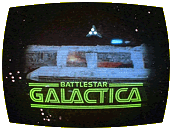
Miniseries: 1978
- The Saga Of A Starworld
Season One: 1978-79
- The Lost Planet Of The Gods – Part 1
- The Lost Planet Of The Gods – Part 2
- The Lost Warrior
- The Long Patrol
- The Gun On Ice Planet Zero – Part 1
- The Gun On Ice Planet Zero – Part 2
- The Magnificent Warriors
- The Young Lords
- The Living Legend – Part 1
- The Living Legend – Part 2
- Fire In Space
- War Of The Gods – Part 1
- War Of The Gods – Part 2
- The Man With Nine Lives
- Murder On The Rising Star
- Greetings From Earth
- Baltar’s Escape
- Experiment In Terra
- Take The Celestra!
- The Hand Of God
Season Two (also known as Galactica: 1980): 1980-81
- Galactica Discovers Earth
- The Super Scouts – Part 1
- The Super Scouts – Part 2
- Spaceball
- The Night The Cylons Landed – Part 1
- The Night The Cylons Landed – Part 2
- Space Croppers
- The Return Of Starbuck
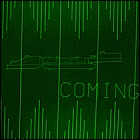 Inspired by his fascination with science fiction, mythology, and his Mormon roots with their emphasis on tracing family history, television producer Glen A. Larson created one of the definitive SF series of the 1970s, and one of the few such series to thrive – even briefly – on American TV during that time. Originally conceived as a six-hour miniseries with a possible series to follow, Battlestar Galactica came into being by arriving on the heels of an unexpected cinematic phenomenon. 20th Century Fox and George Lucas ushered in the era of the high-budget big screen blockbuster in May 1977 with Star Wars,
Inspired by his fascination with science fiction, mythology, and his Mormon roots with their emphasis on tracing family history, television producer Glen A. Larson created one of the definitive SF series of the 1970s, and one of the few such series to thrive – even briefly – on American TV during that time. Originally conceived as a six-hour miniseries with a possible series to follow, Battlestar Galactica came into being by arriving on the heels of an unexpected cinematic phenomenon. 20th Century Fox and George Lucas ushered in the era of the high-budget big screen blockbuster in May 1977 with Star Wars, 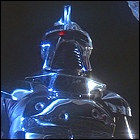 and Universal – the studio for whom Larson created and guided new projects – saw the seasoned producer’s pitch as timely and profitable. Universal was able to sell the potential miniseries to ABC, though the network and the studio were both enthused enough by the project to greenlight not a six-hour event, but a three-hour pilot followed by a full weekly series.
and Universal – the studio for whom Larson created and guided new projects – saw the seasoned producer’s pitch as timely and profitable. Universal was able to sell the potential miniseries to ABC, though the network and the studio were both enthused enough by the project to greenlight not a six-hour event, but a three-hour pilot followed by a full weekly series.
While this was an attractive option to the entities buying and selling the show, it would become a nearly insurmountable obstacle to those charged with making it. Larson wasn’t short on ideas, and 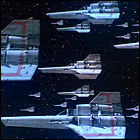 neither were the writers and producers he brought in to create more stories. Special effects legend John Dykstra signed on as a producer as well, overseeing the look of the show. But it was that look – flashy optical effects on a scale never before seen on TV – that would prove to be the show’s downfall. Those effects were not only prohibitively expensive even for a major motion picture – more than anything, they were time-consuming. This early era of motion control and blue screen photography was still in its infancy, and it was highly unorthodox to see a movie lean so heavily on those effects – let alone a TV series, which would need new effects produced on a weekly basis.
neither were the writers and producers he brought in to create more stories. Special effects legend John Dykstra signed on as a producer as well, overseeing the look of the show. But it was that look – flashy optical effects on a scale never before seen on TV – that would prove to be the show’s downfall. Those effects were not only prohibitively expensive even for a major motion picture – more than anything, they were time-consuming. This early era of motion control and blue screen photography was still in its infancy, and it was highly unorthodox to see a movie lean so heavily on those effects – let alone a TV series, which would need new effects produced on a weekly basis.
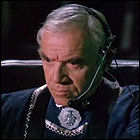 Larson set about assembling a cast for what he envisioned as the drama of an extended family in space. His biggest coup in casting was undoubtedly in landing the legendary Lorne Greene – late of the hit western series Bonanza – for the lead role of Commander Adama. Wise, wily, and occasionally crotchety, Adama would give the show and its characters their emotional and moralistic core. His son Apollo would handle much of the series’ action, along with a devil-
Larson set about assembling a cast for what he envisioned as the drama of an extended family in space. His biggest coup in casting was undoubtedly in landing the legendary Lorne Greene – late of the hit western series Bonanza – for the lead role of Commander Adama. Wise, wily, and occasionally crotchety, Adama would give the show and its characters their emotional and moralistic core. His son Apollo would handle much of the series’ action, along with a devil-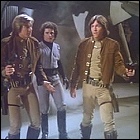 may-care hotshot pilot named Starbuck – very much, it could be argued, set in the mold of Star Wars‘ Han Solo. Dirk Benedict quickly stepped into the boots of the cigar-chomping Starbuck, while Apollo took longer to cast; a young actor named Richard Hatch had been sent the script, but he had declined an invitation to audition. Hatch was set on finding more prestigious, serious projects to pursue and further his career. Finally, he was persuaded to try out for the role of Apollo and landed the part with Larson’s assurances that Galactica would handle its storytelling more seriously than the TV science fiction that had come before it.
may-care hotshot pilot named Starbuck – very much, it could be argued, set in the mold of Star Wars‘ Han Solo. Dirk Benedict quickly stepped into the boots of the cigar-chomping Starbuck, while Apollo took longer to cast; a young actor named Richard Hatch had been sent the script, but he had declined an invitation to audition. Hatch was set on finding more prestigious, serious projects to pursue and further his career. Finally, he was persuaded to try out for the role of Apollo and landed the part with Larson’s assurances that Galactica would handle its storytelling more seriously than the TV science fiction that had come before it.
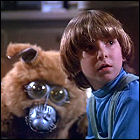 The cast was rounded out with film veterans and newcomers alike – model Maren Jensen and child actor Noah Hathaway Jr. won the parts of, respectively, Adama’s daughter Athena and Apollo’s adopted son Boxey. Herbert Jefferson Jr. filled out the ranks of Galactica’s pilot squaron as Lt. Boomer, while Terry Carter would take on the role of Colonel Tigh, Galactica’s first officer. Hollywood veteran John Colicos would be the villain of the piece as the traitorous human Baltar, while an uncredited Patrick MacNee (The Avengers)
The cast was rounded out with film veterans and newcomers alike – model Maren Jensen and child actor Noah Hathaway Jr. won the parts of, respectively, Adama’s daughter Athena and Apollo’s adopted son Boxey. Herbert Jefferson Jr. filled out the ranks of Galactica’s pilot squaron as Lt. Boomer, while Terry Carter would take on the role of Colonel Tigh, Galactica’s first officer. Hollywood veteran John Colicos would be the villain of the piece as the traitorous human Baltar, while an uncredited Patrick MacNee (The Avengers) 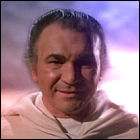 provided the voice of the Cylons’ Imperious Leader and the third-person narration that opened almost every episode; MacNee would later appear in the flesh in a more substantial and sinister role. Finally, well on her way to being dubbed the “miniseries queen,” a young Jane Seymour signed on for the pilot and two additional hourly episodes, though members of both the cast and production crew later regretted not contracting her as a series regular.
provided the voice of the Cylons’ Imperious Leader and the third-person narration that opened almost every episode; MacNee would later appear in the flesh in a more substantial and sinister role. Finally, well on her way to being dubbed the “miniseries queen,” a young Jane Seymour signed on for the pilot and two additional hourly episodes, though members of both the cast and production crew later regretted not contracting her as a series regular.
And the alien hordes at Baltar’s command? Larson’s script called for a mechanical menace known as the Cylons. Though the Cylons would exact a high cost from humanity in the pilot movie, they also cost 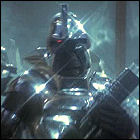 the production a great deal as well. Their chrome-plated plastic armor had to be specially molded to be worn over black bodysuits, and the producers insisted on casting actors at least six feet tall to literally heighten the Cylon menace. The helmets of foreground Cylons included a pulsing, rotating red light, and their voices were dubbed with an early generation of speech synthesis equipment – equipment that wasn’t cheap. Not that anything else about the Cylons was inexpensive, either: when “stunt” Cylons were fitted with explosive squibs for laser battles, the plastic armor was frequently damaged beyond any hope of reusing that portion of the costumes.
the production a great deal as well. Their chrome-plated plastic armor had to be specially molded to be worn over black bodysuits, and the producers insisted on casting actors at least six feet tall to literally heighten the Cylon menace. The helmets of foreground Cylons included a pulsing, rotating red light, and their voices were dubbed with an early generation of speech synthesis equipment – equipment that wasn’t cheap. Not that anything else about the Cylons was inexpensive, either: when “stunt” Cylons were fitted with explosive squibs for laser battles, the plastic armor was frequently damaged beyond any hope of reusing that portion of the costumes. 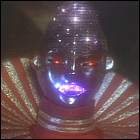 Though special lighting and careful camera work made the Cylons a formidable foe on film, their all-conquering ranks would eventually be extinguished by the series’ rapidly-dwindling effects budget.
Though special lighting and careful camera work made the Cylons a formidable foe on film, their all-conquering ranks would eventually be extinguished by the series’ rapidly-dwindling effects budget.
Riding high on the wave of Star Wars mania, Battlestar Galactica premiered in ABC’s fall 1978 schedule, earning some of the highest prime time ratings the network had achieved in recent years. Though some of the rough edges showed – spacefight scenes were frequently reused several times over in the space of a single episode or even within the same battle sequence, and an early effects shot of the Galactica herself dismally failed to hide a support pylon holding the model up – the audience seemed to be primed for a weekly science fiction blockbuster. There was 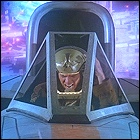 only one problem: the demands on the show’s budget and the production crew’s time threatened to make several episodes miss their network delivery dates, let alone their broadcast windows. Much of the prep work had been done assuming that Battlestar Galactica would be a miniseries, and the first half of its freshman season was weighted down with expensive two-part epics, featuring visits to forbidding environments like an ice planet, massive confrontations between huge starships and their attendant fleets of fighters, and enormous sets. Big-name guest stars like Lloyd Bridges, though a draw for the audience, were an added expense.
only one problem: the demands on the show’s budget and the production crew’s time threatened to make several episodes miss their network delivery dates, let alone their broadcast windows. Much of the prep work had been done assuming that Battlestar Galactica would be a miniseries, and the first half of its freshman season was weighted down with expensive two-part epics, featuring visits to forbidding environments like an ice planet, massive confrontations between huge starships and their attendant fleets of fighters, and enormous sets. Big-name guest stars like Lloyd Bridges, though a draw for the audience, were an added expense. 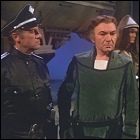 Battlestar Galactica’s budget was already nearly exhausted, even with the judicious reuse of special effects elements.
Battlestar Galactica’s budget was already nearly exhausted, even with the judicious reuse of special effects elements.
As the season progressed, the Cylon threat seemed to fade into the background as Galactica wandered into the territory of the “Eastern Alliance,” leading the series briefly into a somewhat heavy-handed Cold War allegory (and not a well-planned one, either; in their first appearance, the Eastern Alliance dressed and spoke like Nazis, while their next appearance painted them in more of a Russian light, with uniforms and accents to match, and an eager finger on the 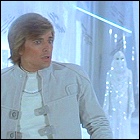 trigger of a nuclear arsenal). One of these episodes, Experiment In Terra, gave co-producer Donald Bellisario a chance to try out an interesting storytelling device in which a member of Galactica’s crew would infiltrate a more primitive society, but would appear to those people as one of their own. This concept only appeared once in Galactica, but Bellisario would later create an entire series around that premise and call it Quantum Leap.
trigger of a nuclear arsenal). One of these episodes, Experiment In Terra, gave co-producer Donald Bellisario a chance to try out an interesting storytelling device in which a member of Galactica’s crew would infiltrate a more primitive society, but would appear to those people as one of their own. This concept only appeared once in Galactica, but Bellisario would later create an entire series around that premise and call it Quantum Leap.
Struggling to meet each network delivery date, Battlestar Galactica finally reached the end of its first season, and both cast and crew awaited a second season pickup or cancellation. What did happen was completely unexpected. ABC wanted the show to continue, and Universal was game – if significant changes were made to the series 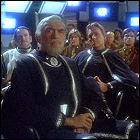 format. Apollo, Starbuck, Boomer, Boxey and the other familiar characters would vanish in the second season, as would the expensive interplanetary voyages. Instead, Galactica would find Earth in the second season premiere – but it would be modern-day Earth, something that could be represented with relatively inexpensive location shooting. The Cylons made only the briefest of appearances, and of the original cast only Adama remained. The bulk of the show involved members of Galactica’s crew interacting with Earth people of the year 1980. Larson washed his hands of the show and instead concentrated all of his efforts on another project he had recently started, a modern-day retelling of
format. Apollo, Starbuck, Boomer, Boxey and the other familiar characters would vanish in the second season, as would the expensive interplanetary voyages. Instead, Galactica would find Earth in the second season premiere – but it would be modern-day Earth, something that could be represented with relatively inexpensive location shooting. The Cylons made only the briefest of appearances, and of the original cast only Adama remained. The bulk of the show involved members of Galactica’s crew interacting with Earth people of the year 1980. Larson washed his hands of the show and instead concentrated all of his efforts on another project he had recently started, a modern-day retelling of 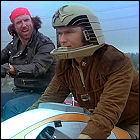 the Buck Rogers comics. Fans looking forward to the continuation of the first season’s promising tapestry of stories abandoned the new season in droves. The final episode was written by Larson himself, and guest starred Dirk Benedict as Starbuck, with a Cylon in tow, trying to tie up some loose ends from the first season – and still failing to draw viewers back to the show. Galactica: 1980, as the show had now come to be known, was quietly cancelled – and given the sweeping changes to the show, there was no fan outcry to save it.
the Buck Rogers comics. Fans looking forward to the continuation of the first season’s promising tapestry of stories abandoned the new season in droves. The final episode was written by Larson himself, and guest starred Dirk Benedict as Starbuck, with a Cylon in tow, trying to tie up some loose ends from the first season – and still failing to draw viewers back to the show. Galactica: 1980, as the show had now come to be known, was quietly cancelled – and given the sweeping changes to the show, there was no fan outcry to save it.
Battlestar Galactica entered syndication in a few markets, but didn’t regain anything more than a small, tightly-knit fan cult until the episodes of both series reappeared on the Sci-Fi Channel’s early lineup. Launched by Universal Studios and USA Network, Sci-Fi 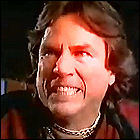 Channel’s original schedule was heavy with Universal-produced shows including Galactica and Buck Rogers. A fan favorite on the convention circuit, actor Richard Hatch – who had originally turned down the role of Apollo – began to hatch his own ideas for a revival of the series. In the intervening years since production had wound down, Lorne Greene had died, so Hatch naturally assumed that Apollo would now be leading Galactica’s mission. A short pitch reel detailing the premise for new Galactica adventures was produced and shopped around to Universal Studios and Glen Larson, and shown during Hatch’s convention appearances in the
Channel’s original schedule was heavy with Universal-produced shows including Galactica and Buck Rogers. A fan favorite on the convention circuit, actor Richard Hatch – who had originally turned down the role of Apollo – began to hatch his own ideas for a revival of the series. In the intervening years since production had wound down, Lorne Greene had died, so Hatch naturally assumed that Apollo would now be leading Galactica’s mission. A short pitch reel detailing the premise for new Galactica adventures was produced and shopped around to Universal Studios and Glen Larson, and shown during Hatch’s convention appearances in the 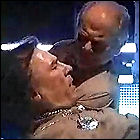 1990s, and many fans were eager to see him revive the show – but Universal held out, not granting Hatch the rights to do so (partly due to an extended legal custody battle with Larson to determine who really held the rights in the first place). Hatch was able to get permission to begin co-writing a series of officially licensed novels continuing the Battlestar’s voyages, and despite not being limited by Lorne Greene’s death, he essentially reused the plotline laid out in his new series proposal, with Adama having died and Apollo assuming command.
1990s, and many fans were eager to see him revive the show – but Universal held out, not granting Hatch the rights to do so (partly due to an extended legal custody battle with Larson to determine who really held the rights in the first place). Hatch was able to get permission to begin co-writing a series of officially licensed novels continuing the Battlestar’s voyages, and despite not being limited by Lorne Greene’s death, he essentially reused the plotline laid out in his new series proposal, with Adama having died and Apollo assuming command.
What Hatch didn’t expect was for Universal to grant the rights to someone else to relaunch Galactica. A proposal to retell the story from the ground up, without continuing the existing storyline, ultimately won the studio’s approval, and the project was 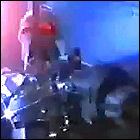 eventually picked up by the Sci-Fi Channel. At first, Bryan Singer, director of the recent hit movie X-Men, was behind the project, but he and creative partner Tom DeSanto dropped out of the project very early on. Ronald D. Moore, who had launched his writing career with a spec script submitted and produced in the third season of Star Trek: The Next Generation, and had continued through the end of that show and then worked on the latter four seasons of spinoff series Deep Space Nine, signed on to produce and co-write the new script, based loosely on Larson’s original pilot. The new Galactica would be darker, grittier and more realistic, Moore promised – and less camp. In the background, Richard Hatch – backed up by a vocal segment of fandom – protested the new direction for the show, but they were ultimately ignored.
eventually picked up by the Sci-Fi Channel. At first, Bryan Singer, director of the recent hit movie X-Men, was behind the project, but he and creative partner Tom DeSanto dropped out of the project very early on. Ronald D. Moore, who had launched his writing career with a spec script submitted and produced in the third season of Star Trek: The Next Generation, and had continued through the end of that show and then worked on the latter four seasons of spinoff series Deep Space Nine, signed on to produce and co-write the new script, based loosely on Larson’s original pilot. The new Galactica would be darker, grittier and more realistic, Moore promised – and less camp. In the background, Richard Hatch – backed up by a vocal segment of fandom – protested the new direction for the show, but they were ultimately ignored.
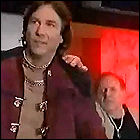 When reports began to surface that more significant changes were being planned, however, it appeared to some fans as though Hatch might have a point. The first, and most frequently touted, change was for the fan favorite character of Starbuck – rumored early on to be a cigar-chomping hotshot female pilot. Again, vocal fans questioned the changes and some even proposed a boycott, but when Sci-Fi premiered the lavishly-produced miniseries pilot in December 2003, Battlestar Galactica was again a ratings winner, beating out most of the network’s other original
When reports began to surface that more significant changes were being planned, however, it appeared to some fans as though Hatch might have a point. The first, and most frequently touted, change was for the fan favorite character of Starbuck – rumored early on to be a cigar-chomping hotshot female pilot. Again, vocal fans questioned the changes and some even proposed a boycott, but when Sci-Fi premiered the lavishly-produced miniseries pilot in December 2003, Battlestar Galactica was again a ratings winner, beating out most of the network’s other original 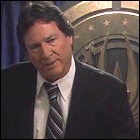 programming that year, surprising some of the fans and disappointing others, and meriting a 13-episode series production order in 2004.
programming that year, surprising some of the fans and disappointing others, and meriting a 13-episode series production order in 2004.
A further twist awaited Hatch: in an effort to smooth things over with fandom, the producers of the new remake cast Hatch as a political agitator, pitting him against the already-uneasy duo of Commander Adama and President Laura Roslin in a series of infrequent guest appearances spanning the series’ entire run. Not long after the conclusion of the Galactica reboot – which had, during its run, become one of the most-acclaimed SF series in television history – Universal announced yet another revival of Galactica would be put into production, hewing more closely to the original 1970s TV series but still not Hatch’s continuation, and completely unrelated to the Ronald D. Moore series of the 2000s. The third iteration of 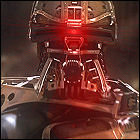 Galactica is slated to be a movie, ensuring that somewhere out there, there’s still a ragtag fleet looking for a shining beacon called Earth; in the meantime, Syfy (formerly Sci-Fi Channel) continues to attempt a successful continuation to the Moore series, though finding a series formula that wins the kind of ratings that the remake did has already taken them through one cancelled prequel (Caprica) and another prequel with a troubled production history (Blood & Chrome).
Galactica is slated to be a movie, ensuring that somewhere out there, there’s still a ragtag fleet looking for a shining beacon called Earth; in the meantime, Syfy (formerly Sci-Fi Channel) continues to attempt a successful continuation to the Moore series, though finding a series formula that wins the kind of ratings that the remake did has already taken them through one cancelled prequel (Caprica) and another prequel with a troubled production history (Blood & Chrome).

 The Different Ones: 17-year-old Victor Koch is kept hidden away in isolation by his father, Paul, due to a physical deformity, but does not take kindly to that isolation, whether his father means well or not. Paul contacts a government agency dealing with cases like Victor’s, and is offered three options: taking no action, euthanizing Victor, or sending Victor to another planet as part of an exchange program that would welcome him with open arms. Paul opts for the most merciful of these options, sending Victor to the planet Boreon. But who will Boreon send as an exchange student to Earth?
The Different Ones: 17-year-old Victor Koch is kept hidden away in isolation by his father, Paul, due to a physical deformity, but does not take kindly to that isolation, whether his father means well or not. Paul contacts a government agency dealing with cases like Victor’s, and is offered three options: taking no action, euthanizing Victor, or sending Victor to another planet as part of an exchange program that would welcome him with open arms. Paul opts for the most merciful of these options, sending Victor to the planet Boreon. But who will Boreon send as an exchange student to Earth?written by Rod Serling
teleplay by Gerald Sanford
teleplay by Robert Bloch

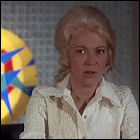




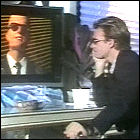 written by Paul Owen & David Hansen and Tim John
written by Paul Owen & David Hansen and Tim John Inspired by his fascination with science fiction, mythology, and his Mormon roots with their emphasis on tracing family history, television producer Glen A. Larson created one of the definitive SF series of the 1970s, and one of the few such series to thrive – even briefly – on American TV during that time. Originally conceived as a six-hour miniseries with a possible series to follow, Battlestar Galactica came into being by arriving on the heels of an unexpected cinematic phenomenon. 20th Century Fox and George Lucas ushered in the era of the high-budget big screen blockbuster in May 1977 with Star Wars,
Inspired by his fascination with science fiction, mythology, and his Mormon roots with their emphasis on tracing family history, television producer Glen A. Larson created one of the definitive SF series of the 1970s, and one of the few such series to thrive – even briefly – on American TV during that time. Originally conceived as a six-hour miniseries with a possible series to follow, Battlestar Galactica came into being by arriving on the heels of an unexpected cinematic phenomenon. 20th Century Fox and George Lucas ushered in the era of the high-budget big screen blockbuster in May 1977 with Star Wars,  and Universal – the studio for whom Larson created and guided new projects – saw the seasoned producer’s pitch as timely and profitable. Universal was able to sell the potential miniseries to ABC, though the network and the studio were both enthused enough by the project to greenlight not a six-hour event, but a three-hour pilot followed by a full weekly series.
and Universal – the studio for whom Larson created and guided new projects – saw the seasoned producer’s pitch as timely and profitable. Universal was able to sell the potential miniseries to ABC, though the network and the studio were both enthused enough by the project to greenlight not a six-hour event, but a three-hour pilot followed by a full weekly series. neither were the writers and producers he brought in to create more stories. Special effects legend John Dykstra signed on as a producer as well, overseeing the look of the show. But it was that look – flashy optical effects on a scale never before seen on TV – that would prove to be the show’s downfall. Those effects were not only prohibitively expensive even for a major motion picture – more than anything, they were time-consuming. This early era of motion control and blue screen photography was still in its infancy, and it was highly unorthodox to see a movie lean so heavily on those effects – let alone a TV series, which would need new effects produced on a weekly basis.
neither were the writers and producers he brought in to create more stories. Special effects legend John Dykstra signed on as a producer as well, overseeing the look of the show. But it was that look – flashy optical effects on a scale never before seen on TV – that would prove to be the show’s downfall. Those effects were not only prohibitively expensive even for a major motion picture – more than anything, they were time-consuming. This early era of motion control and blue screen photography was still in its infancy, and it was highly unorthodox to see a movie lean so heavily on those effects – let alone a TV series, which would need new effects produced on a weekly basis. Larson set about assembling a cast for what he envisioned as the drama of an extended family in space. His biggest coup in casting was undoubtedly in landing the legendary Lorne Greene – late of the hit western series Bonanza – for the lead role of Commander Adama. Wise, wily, and occasionally crotchety, Adama would give the show and its characters their emotional and moralistic core. His son Apollo would handle much of the series’ action, along with a devil-
Larson set about assembling a cast for what he envisioned as the drama of an extended family in space. His biggest coup in casting was undoubtedly in landing the legendary Lorne Greene – late of the hit western series Bonanza – for the lead role of Commander Adama. Wise, wily, and occasionally crotchety, Adama would give the show and its characters their emotional and moralistic core. His son Apollo would handle much of the series’ action, along with a devil- may-care hotshot pilot named Starbuck – very much, it could be argued, set in the mold of Star Wars‘ Han Solo. Dirk Benedict quickly stepped into the boots of the cigar-chomping Starbuck, while Apollo took longer to cast; a young actor named Richard Hatch had been sent the script, but he had declined an invitation to audition. Hatch was set on finding more prestigious, serious projects to pursue and further his career. Finally, he was persuaded to try out for the role of Apollo and landed the part with Larson’s assurances that Galactica would handle its storytelling more seriously than the TV science fiction that had come before it.
may-care hotshot pilot named Starbuck – very much, it could be argued, set in the mold of Star Wars‘ Han Solo. Dirk Benedict quickly stepped into the boots of the cigar-chomping Starbuck, while Apollo took longer to cast; a young actor named Richard Hatch had been sent the script, but he had declined an invitation to audition. Hatch was set on finding more prestigious, serious projects to pursue and further his career. Finally, he was persuaded to try out for the role of Apollo and landed the part with Larson’s assurances that Galactica would handle its storytelling more seriously than the TV science fiction that had come before it. The cast was rounded out with film veterans and newcomers alike – model Maren Jensen and child actor Noah Hathaway Jr. won the parts of, respectively, Adama’s daughter Athena and Apollo’s adopted son Boxey. Herbert Jefferson Jr. filled out the ranks of Galactica’s pilot squaron as Lt. Boomer, while Terry Carter would take on the role of Colonel Tigh, Galactica’s first officer. Hollywood veteran John Colicos would be the villain of the piece as the traitorous human Baltar, while an uncredited Patrick MacNee (The Avengers)
The cast was rounded out with film veterans and newcomers alike – model Maren Jensen and child actor Noah Hathaway Jr. won the parts of, respectively, Adama’s daughter Athena and Apollo’s adopted son Boxey. Herbert Jefferson Jr. filled out the ranks of Galactica’s pilot squaron as Lt. Boomer, while Terry Carter would take on the role of Colonel Tigh, Galactica’s first officer. Hollywood veteran John Colicos would be the villain of the piece as the traitorous human Baltar, while an uncredited Patrick MacNee (The Avengers)  provided the voice of the Cylons’ Imperious Leader and the third-person narration that opened almost every episode; MacNee would later appear in the flesh in a more substantial and sinister role. Finally, well on her way to being dubbed the “miniseries queen,” a young Jane Seymour signed on for the pilot and two additional hourly episodes, though members of both the cast and production crew later regretted not contracting her as a series regular.
provided the voice of the Cylons’ Imperious Leader and the third-person narration that opened almost every episode; MacNee would later appear in the flesh in a more substantial and sinister role. Finally, well on her way to being dubbed the “miniseries queen,” a young Jane Seymour signed on for the pilot and two additional hourly episodes, though members of both the cast and production crew later regretted not contracting her as a series regular. the production a great deal as well. Their chrome-plated plastic armor had to be specially molded to be worn over black bodysuits, and the producers insisted on casting actors at least six feet tall to literally heighten the Cylon menace. The helmets of foreground Cylons included a pulsing, rotating red light, and their voices were dubbed with an early generation of speech synthesis equipment – equipment that wasn’t cheap. Not that anything else about the Cylons was inexpensive, either: when “stunt” Cylons were fitted with explosive squibs for laser battles, the plastic armor was frequently damaged beyond any hope of reusing that portion of the costumes.
the production a great deal as well. Their chrome-plated plastic armor had to be specially molded to be worn over black bodysuits, and the producers insisted on casting actors at least six feet tall to literally heighten the Cylon menace. The helmets of foreground Cylons included a pulsing, rotating red light, and their voices were dubbed with an early generation of speech synthesis equipment – equipment that wasn’t cheap. Not that anything else about the Cylons was inexpensive, either: when “stunt” Cylons were fitted with explosive squibs for laser battles, the plastic armor was frequently damaged beyond any hope of reusing that portion of the costumes.  Though special lighting and careful camera work made the Cylons a formidable foe on film, their all-conquering ranks would eventually be extinguished by the series’ rapidly-dwindling effects budget.
Though special lighting and careful camera work made the Cylons a formidable foe on film, their all-conquering ranks would eventually be extinguished by the series’ rapidly-dwindling effects budget. only one problem: the demands on the show’s budget and the production crew’s time threatened to make several episodes miss their network delivery dates, let alone their broadcast windows. Much of the prep work had been done assuming that Battlestar Galactica would be a miniseries, and the first half of its freshman season was weighted down with expensive two-part epics, featuring visits to forbidding environments like an ice planet, massive confrontations between huge starships and their attendant fleets of fighters, and enormous sets. Big-name guest stars like Lloyd Bridges, though a draw for the audience, were an added expense.
only one problem: the demands on the show’s budget and the production crew’s time threatened to make several episodes miss their network delivery dates, let alone their broadcast windows. Much of the prep work had been done assuming that Battlestar Galactica would be a miniseries, and the first half of its freshman season was weighted down with expensive two-part epics, featuring visits to forbidding environments like an ice planet, massive confrontations between huge starships and their attendant fleets of fighters, and enormous sets. Big-name guest stars like Lloyd Bridges, though a draw for the audience, were an added expense.  Battlestar Galactica’s budget was already nearly exhausted, even with the judicious reuse of special effects elements.
Battlestar Galactica’s budget was already nearly exhausted, even with the judicious reuse of special effects elements. trigger of a nuclear arsenal). One of these episodes, Experiment In Terra, gave co-producer Donald Bellisario a chance to try out an interesting storytelling device in which a member of Galactica’s crew would infiltrate a more primitive society, but would appear to those people as one of their own. This concept only appeared once in Galactica, but Bellisario would later create an entire series around that premise and call it Quantum Leap.
trigger of a nuclear arsenal). One of these episodes, Experiment In Terra, gave co-producer Donald Bellisario a chance to try out an interesting storytelling device in which a member of Galactica’s crew would infiltrate a more primitive society, but would appear to those people as one of their own. This concept only appeared once in Galactica, but Bellisario would later create an entire series around that premise and call it Quantum Leap. format. Apollo, Starbuck, Boomer, Boxey and the other familiar characters would vanish in the second season, as would the expensive interplanetary voyages. Instead, Galactica would find Earth in the second season premiere – but it would be modern-day Earth, something that could be represented with relatively inexpensive location shooting. The Cylons made only the briefest of appearances, and of the original cast only Adama remained. The bulk of the show involved members of Galactica’s crew interacting with Earth people of the year 1980. Larson washed his hands of the show and instead concentrated all of his efforts on another project he had recently started, a modern-day retelling of
format. Apollo, Starbuck, Boomer, Boxey and the other familiar characters would vanish in the second season, as would the expensive interplanetary voyages. Instead, Galactica would find Earth in the second season premiere – but it would be modern-day Earth, something that could be represented with relatively inexpensive location shooting. The Cylons made only the briefest of appearances, and of the original cast only Adama remained. The bulk of the show involved members of Galactica’s crew interacting with Earth people of the year 1980. Larson washed his hands of the show and instead concentrated all of his efforts on another project he had recently started, a modern-day retelling of  the Buck Rogers comics. Fans looking forward to the continuation of the first season’s promising tapestry of stories abandoned the new season in droves. The final episode was written by Larson himself, and guest starred Dirk Benedict as Starbuck, with a Cylon in tow, trying to tie up some loose ends from the first season – and still failing to draw viewers back to the show. Galactica: 1980, as the show had now come to be known, was quietly cancelled – and given the sweeping changes to the show, there was no fan outcry to save it.
the Buck Rogers comics. Fans looking forward to the continuation of the first season’s promising tapestry of stories abandoned the new season in droves. The final episode was written by Larson himself, and guest starred Dirk Benedict as Starbuck, with a Cylon in tow, trying to tie up some loose ends from the first season – and still failing to draw viewers back to the show. Galactica: 1980, as the show had now come to be known, was quietly cancelled – and given the sweeping changes to the show, there was no fan outcry to save it. Channel’s original schedule was heavy with Universal-produced shows including Galactica and Buck Rogers. A fan favorite on the convention circuit, actor Richard Hatch – who had originally turned down the role of Apollo – began to hatch his own ideas for a revival of the series. In the intervening years since production had wound down, Lorne Greene had died, so Hatch naturally assumed that Apollo would now be leading Galactica’s mission. A short pitch reel detailing the premise for new Galactica adventures was produced and shopped around to Universal Studios and Glen Larson, and shown during Hatch’s convention appearances in the
Channel’s original schedule was heavy with Universal-produced shows including Galactica and Buck Rogers. A fan favorite on the convention circuit, actor Richard Hatch – who had originally turned down the role of Apollo – began to hatch his own ideas for a revival of the series. In the intervening years since production had wound down, Lorne Greene had died, so Hatch naturally assumed that Apollo would now be leading Galactica’s mission. A short pitch reel detailing the premise for new Galactica adventures was produced and shopped around to Universal Studios and Glen Larson, and shown during Hatch’s convention appearances in the  1990s, and many fans were eager to see him revive the show – but Universal held out, not granting Hatch the rights to do so (partly due to an extended legal custody battle with Larson to determine who really held the rights in the first place). Hatch was able to get permission to begin co-writing a series of officially licensed novels continuing the Battlestar’s voyages, and despite not being limited by Lorne Greene’s death, he essentially reused the plotline laid out in his new series proposal, with Adama having died and Apollo assuming command.
1990s, and many fans were eager to see him revive the show – but Universal held out, not granting Hatch the rights to do so (partly due to an extended legal custody battle with Larson to determine who really held the rights in the first place). Hatch was able to get permission to begin co-writing a series of officially licensed novels continuing the Battlestar’s voyages, and despite not being limited by Lorne Greene’s death, he essentially reused the plotline laid out in his new series proposal, with Adama having died and Apollo assuming command. eventually picked up by the Sci-Fi Channel. At first, Bryan Singer, director of the recent hit movie X-Men, was behind the project, but he and creative partner Tom DeSanto dropped out of the project very early on. Ronald D. Moore, who had launched his writing career with a spec script submitted and produced in the third season of Star Trek: The Next Generation, and had continued through the end of that show and then worked on the latter four seasons of spinoff series Deep Space Nine, signed on to produce and co-write the new script, based loosely on Larson’s original pilot. The new Galactica would be darker, grittier and more realistic, Moore promised – and less camp. In the background, Richard Hatch – backed up by a vocal segment of fandom – protested the new direction for the show, but they were ultimately ignored.
eventually picked up by the Sci-Fi Channel. At first, Bryan Singer, director of the recent hit movie X-Men, was behind the project, but he and creative partner Tom DeSanto dropped out of the project very early on. Ronald D. Moore, who had launched his writing career with a spec script submitted and produced in the third season of Star Trek: The Next Generation, and had continued through the end of that show and then worked on the latter four seasons of spinoff series Deep Space Nine, signed on to produce and co-write the new script, based loosely on Larson’s original pilot. The new Galactica would be darker, grittier and more realistic, Moore promised – and less camp. In the background, Richard Hatch – backed up by a vocal segment of fandom – protested the new direction for the show, but they were ultimately ignored. When reports began to surface that more significant changes were being planned, however, it appeared to some fans as though Hatch might have a point. The first, and most frequently touted, change was for the fan favorite character of Starbuck – rumored early on to be a cigar-chomping hotshot female pilot. Again, vocal fans questioned the changes and some even proposed a boycott, but when Sci-Fi premiered the lavishly-produced miniseries pilot in December 2003, Battlestar Galactica was again a ratings winner, beating out most of the network’s other original
When reports began to surface that more significant changes were being planned, however, it appeared to some fans as though Hatch might have a point. The first, and most frequently touted, change was for the fan favorite character of Starbuck – rumored early on to be a cigar-chomping hotshot female pilot. Again, vocal fans questioned the changes and some even proposed a boycott, but when Sci-Fi premiered the lavishly-produced miniseries pilot in December 2003, Battlestar Galactica was again a ratings winner, beating out most of the network’s other original  programming that year, surprising some of the fans and disappointing others, and meriting a 13-episode series production order in 2004.
programming that year, surprising some of the fans and disappointing others, and meriting a 13-episode series production order in 2004. Galactica is slated to be a movie, ensuring that somewhere out there, there’s still a ragtag fleet looking for a shining beacon called Earth; in the meantime, Syfy (formerly Sci-Fi Channel) continues to attempt a successful continuation to the Moore series, though finding a series formula that wins the kind of ratings that the remake did has already taken them through one cancelled prequel (Caprica) and another prequel with a troubled production history (Blood & Chrome).
Galactica is slated to be a movie, ensuring that somewhere out there, there’s still a ragtag fleet looking for a shining beacon called Earth; in the meantime, Syfy (formerly Sci-Fi Channel) continues to attempt a successful continuation to the Moore series, though finding a series formula that wins the kind of ratings that the remake did has already taken them through one cancelled prequel (Caprica) and another prequel with a troubled production history (Blood & Chrome).


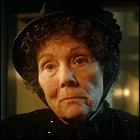 Olivia Vinall (Effie), Michelle Tate (Abigail), Jack Oliver Hudson (Urchin Boy)
Olivia Vinall (Effie), Michelle Tate (Abigail), Jack Oliver Hudson (Urchin Boy)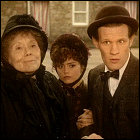 Huntsman.
Huntsman.